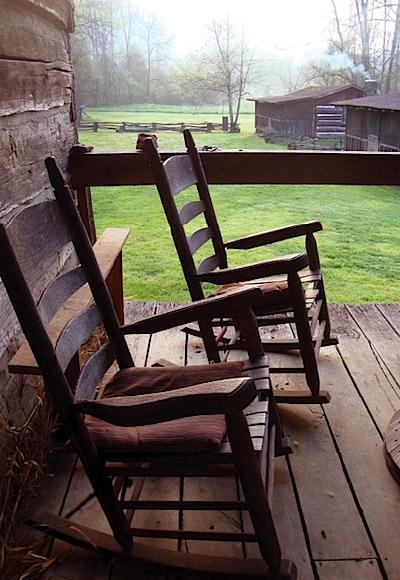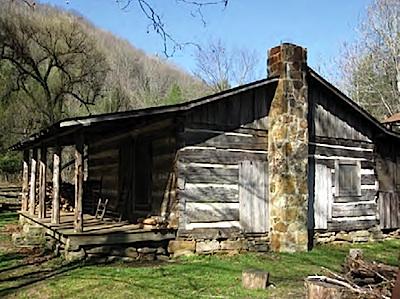
Relaxing in a rocker on the lodge's front porch is a popular after-dinner activity/Jane Schneider
I recently received an invitation to sleep in a log cabin. Not something new and swanky, mind you. Instead, my imagination was sparked because this cabin was built in 1817, around the time Davy Crockett was earning his reputation as a frontiersman, storyteller, and politician.
Charit Creek Lodge sits in the heart of the Big South Fork National River and Recreation Area, near Jamestown, Tennessee. This 125,000-acre swath of wilderness is part of the Cumberland Plateau, an ancient tableland of sandstone and shale that ascends nearly 1,000 feet above the surrounding terrain and stretches diagonally from the Kentucky border across Tennessee to northern Alabama. Long ago carved by flowing waters, the plateau is riddled with beautiful gorges, canyons, rock shelters, and waterfalls.
While just a two-hour's drive from either Nashville or the Great Smoky Mountains National Park, it feels a world away.
Another Place in Time
To get to Charit Creek, you must drive to the trailhead and leave your car. Then you descend, by foot or by horseback, down steep, winding trails for three-quarters of a mile until you reach the narrow gap that opens to a lush hollow. Greeting you is a picturesque collection of buildings'the lodge, homesteader cabins, and a four-crib barn'that harken to when Tennessee was still being explored and settled.
You might be surprised to learn that these are the oldest lodging structures still in use in the National Park System today. I know I was.
Charit Creek, which is on the National Historic Register, has no electricity, which is part of its charm. Instead, the small cabin rooms are outfitted with wooden bunk beds and warmed by pot-bellied stoves. At night, guests dine by candlelight in the rustic dining room before settling by a campfire and gazing up at a sky impossibly brilliant with stars. (You will, however, find a fairly modern bathhouse here.)
I notice the cabin's huge chinked logs. National Park Service Ranger Howard Duncan tells me they were handhewn from poplar, a soft wood that was abundant and easy to work. Isolated by the towering ridges and deep canyons that pepper the plateau, homesteaders didn't have the luxury of hauling timber from nearby sawmills. Instead, they cleared the land and hewed their own logs to build the squat, sturdy cabins that would serve generations to come.
Duncan is native to these parts, and full of stories of the hardy people who blessed the land with names that reflected its challenges: Difficulty, Troublesome, and No Business Creek. Because of its remoteness, Big South Fork was always sparsely populated with many families doing subsistence farming or taking jobs in the boom/bust economies of logging and coal mining in the 1900s.
Once the finest timber had been plucked and the coal extracted, jobs dwindled. Following World War II, people steadily moved off the land. While the U.S. Corps of Engineers proposed damming the river for recreational purposes, others fought to preserve the land. Thus, in 1974, Big South Fork (it is the south fork of the Cumberland River) was created as a national river and recreation area.

Some of the cabins at Charit Creek date to 1817/NPS
Park Superintendent Nikki Nicholas notes that Big South Fork is actually part of a larger plat of open land that includes Daniel Boone National Forest. Having these contiguous spaces 'helps with species restoration and ecosystems management,' says Nicholas. 'There are not that many big chunks of land left in the Eastern U.S. We must have this land to solve these issues.'
Developing Charit Creek
In the evening when dinner is served, the dining room flickers with the soft light shed by kerosene lamps. And while this room is of newer construction (it was actually built during the 1960s when Charit Creek was a hunting lodge), it has the look and feel of its rustic counterparts and the room effectively connects the two cabins that date to the 1800s.
I speak to a group of older women from Syracuse, New York, who relax in the rockers on the cabin's front porch. They caravanned to the park for a two-week retreat, their horse trailers in tow. 'We come here every spring,' one woman offers. 'Big South Fork is a wonderful place to ride.'
Later I hike to Twin Arches, a towering sandstone formation less than a mile from the lodge. The winding trail climbs through a mixed forest of oak, dogwood, and conifers. Big South Fork is part of the world's largest expanse of hardwood-forested plateau.
Since it's late-April at the time of my visit, white and crimson trillium bloom alongside dwarf iris, little brown jugs, and dainty Quaker Ladies bluets, sky blue flowers that dot the forest floor. These are among more than 100 species of wildflowers that blossom here spring to early fall.
I stop briefly at a curious sight: scat alongside a dead mouse and mole, clearly a critter's to-go breakfast before my appearance. I peer into the green, hoping to spy a red fox or raccoon that likely dropped their prize, but no luck.
Finally, I reach the Twin Arches summit. Here I get a bird's-eye view of the park's verdant gorges and sandstone cliffs with the river in the distance. It is a breathtaking sight.
The park offers an abundance of outdoor activities: Visitors can paddle the Big South Fork and fish, ride mountain bike trails, even take a ride on a narrow-gauge railroad that travels to a mining ghost town. Be aware, because of the terrain, it does take time to drive from point to point. But if you're not in a hurry and want to experience an amazing corner of the wilder South, this park is your ticket.



Comments
Sounds like a delightful place and experience. Just out of curiosity, how much does it cost to stay there?
Lee Dalton, here's the facebook site and web site. You can google Charit Creek Lodge also. check for pics....new concessionaires have recently taken over and they're fantastic...great personalities, great cooks I've heard. It's not real inexpensive but worth it.Contact them for any info you need. They're real hospitable.It's a must do if you can...Twin Arches is indescribable!
www.facebook.com/charitcreeklodge
http://www.ccl-bsf.com/
Thank you. At $80 per adult per night, it certainly beats heck out of most park accommodations. As for me, I'd much rather spend a night in a place like than the Ahwanee -- even if I could afford it.
Lee, you are gonna have a hard time finding a Motel-6 for that rate these days.